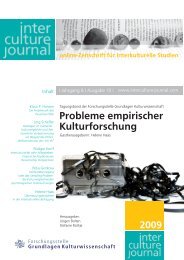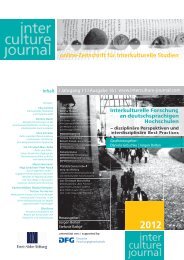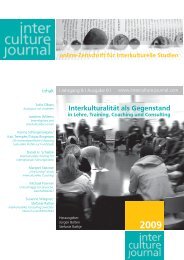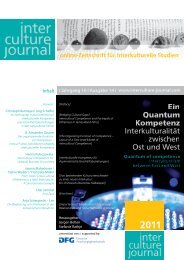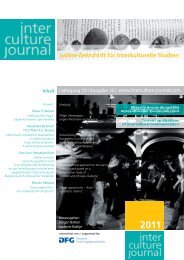Grundlagen Kulturwissenschaft - Interculture Journal
Grundlagen Kulturwissenschaft - Interculture Journal
Grundlagen Kulturwissenschaft - Interculture Journal
Sie wollen auch ein ePaper? Erhöhen Sie die Reichweite Ihrer Titel.
YUMPU macht aus Druck-PDFs automatisch weboptimierte ePaper, die Google liebt.
Rathje: The Definition of Culture: An application-oriented overhaul<br />
explanation of social power differences arising from the unjust<br />
distribution of cultural authority (Bourdieu 1982). Fraser's<br />
model of status recognition likewise distinguishes the authority<br />
of economic exclusion from its cultural value hierarchy in<br />
the disenfranchisement of certain groups despite their possession<br />
of economic capital (Fraser 1995).<br />
These and similar attempts will not be treated here in detail.<br />
What is, however, crucial for the development of an application-oriented<br />
concept of culture is, above all, the division between<br />
an understanding of culture at the level of cultural customs<br />
and the related collective perspective at the level of belonging.<br />
Such a division is, of course, problematic since cultural<br />
practices as communicative codes always contain relationship<br />
cues that reach back to the collective level. Nevertheless,<br />
this division seems to be necessary from a theoretical<br />
perspective, since both levels do not necessarily develop in<br />
concert. Cultural customs can influence collective affiliations,<br />
however - as in the example of purely economic access conditions<br />
to groups –they do not necessarily have to. Furthermore,<br />
group theory demonstrates that shared cultural characteristics<br />
are not a prerequisite for the development of a group<br />
identity and the resulting phenomena of exclusion and devaluation<br />
of outsiders (Tajfel 1982).<br />
Also from a practical standpoint, the separation of cultural<br />
and collective perspective makes sense because their mixture<br />
frequently leads to impasses in discussions of social matters.<br />
This is well illustrated by the recent headscarf (hijab) debates<br />
in France and Germany, for example. A headscarf can act, of<br />
course, on the level of the cultural, simply as a practical article<br />
of clothing like a baseball cap, protecting the individual who<br />
wears it from sun, wind, or rain. It may be nothing more than<br />
a fashionable accessory that fits nicely with the other articles<br />
of clothing an individual chooses to wear or, like a turban or<br />
a hood in certain instances, may indicate an adherence to<br />
certain religious doctrines. On the collective level, the headscarf<br />
may be interpreted like the team scarves common<br />
among European football fans as a tangible political sign of<br />
affiliation with a specific group or the rejection of another.<br />
The social debate on this topic is seldom about the cultural<br />
custom of wearing a certain type of clothing, but rather<br />
about its assumed symbolic power, signifying either the demarcation<br />
of one group or the oppression of another. Mixing<br />
the cultural and collective levels leads to passionate discussions<br />
about headscarf bans (a serious encroachment into the<br />
cultural level), thus preventing - at the collective level - the<br />
necessary political examination of the suspected underlying<br />
problem: the social marginalization or oppression of groups.<br />
41<br />
© <strong>Interculture</strong> <strong>Journal</strong> 2009 | 8



